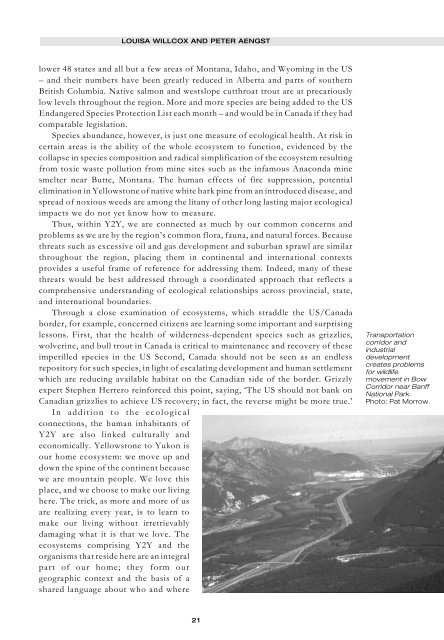Parks - IUCN
Parks - IUCN
Parks - IUCN
Create successful ePaper yourself
Turn your PDF publications into a flip-book with our unique Google optimized e-Paper software.
LOUISA WILLCOX AND PETER AENGST<br />
lower 48 states and all but a few areas of Montana, Idaho, and Wyoming in the US<br />
– and their numbers have been greatly reduced in Alberta and parts of southern<br />
British Columbia. Native salmon and westslope cutthroat trout are at precariously<br />
low levels throughout the region. More and more species are being added to the US<br />
Endangered Species Protection List each month – and would be in Canada if they had<br />
comparable legislation.<br />
Species abundance, however, is just one measure of ecological health. At risk in<br />
certain areas is the ability of the whole ecosystem to function, evidenced by the<br />
collapse in species composition and radical simplification of the ecosystem resulting<br />
from toxic waste pollution from mine sites such as the infamous Anaconda mine<br />
smelter near Butte, Montana. The human effects of fire suppression, potential<br />
elimination in Yellowstone of native white bark pine from an introduced disease, and<br />
spread of noxious weeds are among the litany of other long lasting major ecological<br />
impacts we do not yet know how to measure.<br />
Thus, within Y2Y, we are connected as much by our common concerns and<br />
problems as we are by the region’s common flora, fauna, and natural forces. Because<br />
threats such as excessive oil and gas development and suburban sprawl are similar<br />
throughout the region, placing them in continental and international contexts<br />
provides a useful frame of reference for addressing them. Indeed, many of these<br />
threats would be best addressed through a coordinated approach that reflects a<br />
comprehensive understanding of ecological relationships across provincial, state,<br />
and international boundaries.<br />
Through a close examination of ecosystems, which straddle the US/Canada<br />
border, for example, concerned citizens are learning some important and surprising<br />
lessons. First, that the health of wilderness-dependent species such as grizzlies,<br />
wolverine, and bull trout in Canada is critical to maintenance and recovery of these<br />
imperilled species in the US Second, Canada should not be seen as an endless<br />
repository for such species, in light of escalating development and human settlement<br />
which are reducing available habitat on the Canadian side of the border. Grizzly<br />
expert Stephen Herrero reinforced this point, saying, ‘The US should not bank on<br />
Canadian grizzlies to achieve US recovery; in fact, the reverse might be more true.’<br />
In addition to the ecological<br />
connections, the human inhabitants of<br />
Y2Y are also linked culturally and<br />
economically. Yellowstone to Yukon is<br />
our home ecosystem: we move up and<br />
down the spine of the continent because<br />
we are mountain people. We love this<br />
place, and we choose to make our living<br />
here. The trick, as more and more of us<br />
are realizing every year, is to learn to<br />
make our living without irretrievably<br />
damaging what it is that we love. The<br />
ecosystems comprising Y2Y and the<br />
organisms that reside here are an integral<br />
part of our home; they form our<br />
geographic context and the basis of a<br />
shared language about who and where<br />
21<br />
Transportation<br />
corridor and<br />
industrial<br />
development<br />
creates problems<br />
for wildlife<br />
movement in Bow<br />
Corridor near Banff<br />
National Park.<br />
Photo: Pat Morrow.

















